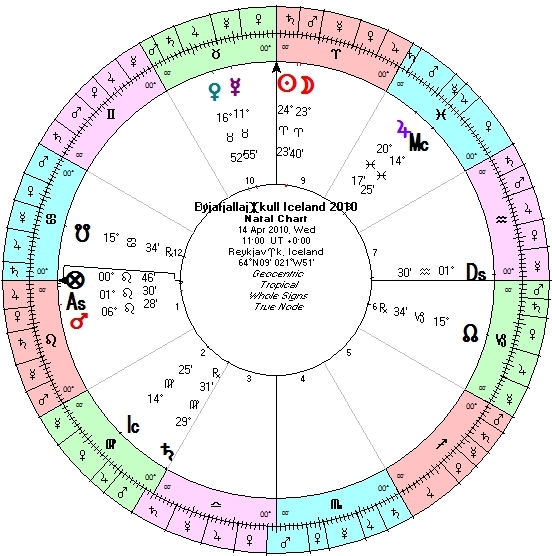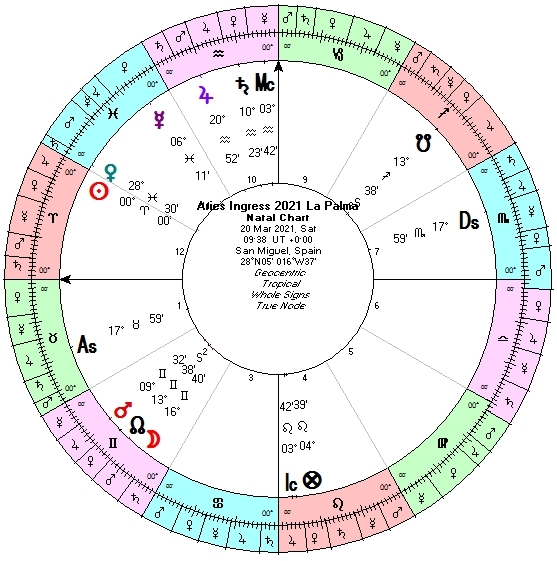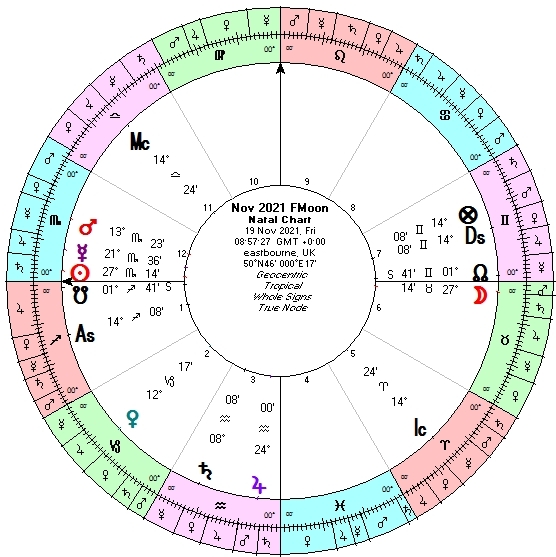-
I recently gave a short presentation to a mundane group on zoom, as to whether or not we can expect a volcanic eruption in the near future that may affect Europe. A couple of months ago the volcano on La Palma began erupting. Three months later it is still throwing out ash and lava. There was talk that if it erupted, it could cause a tsunami with the potential to affect the East Coast of America. After initial interest in the main stream media, the furore has died down, but I thought it worth investigating to see if it’s likely it could go, and if so, when. At the very least, it would provide some instruction on using the planets to predict (or not) the possibility of such an event happening in the future.
Accordingly I looked back at some of the biggest volcanic eruptions we have recorded since Mount Vesuvius buried Pompeii in August AD 79. The main ones in “recent times” are, Mount Tambora in 1815, Krakatoa in 1883, Mount Pele in 1902, Vesuvius in 1906 and the Icelandic volcano in 2010. There are also various ongoing volcanic disturbances around the Ring of Fire, but nothing that may immediately impact Europe. With the exceptions of Tambora, Krakatoa and Mount Pele, the others, although they cause disruption and some loss of life are and were not, catastrophic events.
I decided to look at the Aries ingress prior to the events, the syzergy prior to the Aries Ingress and then the charts of the events themselves.
One of the issues is finding a signature of a volcanic eruption. In various texts Mercury is referred to as wind under the earth, but this primarily relates to earthquakes not volcanic eruptions. In all the texts I consulted mainly from the Persians and Bonatti, there was no mention of “volcano”. They refer to earthquakes and “land falling away”, but the word volcano was conspicuous by its absence.
I had anticipated I would find Mercury, Jupiter and Saturn involved in some way, with Mars acting as a trigger along with Saturn and the eclipses, or lunations involved in some way.
Kusyar Ibn Labban in his Introduction to Astrology (Chapter III)[1] notes that if Mars is in the 4th in an earthy sign and the benefics are in aversion, with Mercury applying to Mars, it also indicates things like fires from the earth, earthquakes and problems with minerals. He says:- “if the 10th of any of these charts is in Aries sign with the malefics, or an unfortunate moon in it, it shows comets and meteors and storms in the heaven, but if the force were earthy and with the same situation we again have earthquakes and a lunar eclipse”.
He continues:] “Saturn, in the fourth place from one of the ascendants of the beginnings which we have mentioned, indicates earthquakes and a lunar eclipse. If the sign is earthy it is more certain in indication. If Mercury is in opposition to it or in conjunction with it, it is <still> more certain. If the Moon is made unfortunate by it (Saturn), it is <still> more certain. [3] When each one of Mars and Saturn is rising in the orb of its apogee, it is more powerful concerning what happens in what we mentioned. As for Mars it concerns the occurrence of meteors, and as for Saturn it concerns the occurrence of earthquakes.
[4] Mars in the cardine of the earth (i.e., the fourth place), when the sign is earthy while the benefics are cadent from it and Mercury is applying to it, indicates earthquakes, the appearance of conflagrations from the earth (I think this refers to Volcanoes), the abundance of quakes, and the pollution of minerals.”
I looked at many charts and events and found that Jupiter was often found to be in Aquarius, but there was not an apparent hard or trigger aspect from Mars, or any eclipses.
For the sake of brevity I will only include a few event charts and then various charts relating to La Palma.
La Palma is one of the islands off the coast of Morocco, owned by Spain and collectively known as the Canary Islands. La Palma is the westernmost of the Isles. I used the main city of San Miguel as the focal point for the charts.
Before coming to the La Palma charts, I will start with the chart for 10th April 1815. Mount Tambora.
Mount Tambora is found on the island of Sumbawa, Indonesia and is still active. On the day of the explosion, the mountain lost around 4,000 feet in height. It had been recorded at a height of approximately 14,000 feet to just under 10,000. According to some sites on the internet, it ejected roughly 31 cubic miles of smoke and ash which circumnavigated the globe and led to the Year without Summer! There were food shortages, flooding, crops failed causing starvation, and many deaths globally from the gas cloud that accompanied the explosions.

The next event was Krakatoa in 1883, again located in Indonesia. News of this eruption travelled quickly owing to the recent installation of the Telegraph system which had been invented in 1830/40. Krakatoa had started erupting in May 1885 but exploded August 1885. The blast from this eruption was heard over 3,000 miles away, and thanks to the recently installed barographs around the world, it appears the shock waves travelled around the globe 4 times in all. It caused huge a mega tsunami and had a long lasting effect on the weather globally. For more on this eruption see www.theatlantic.com/magazine/archive/1884/09/the-volcanic-eruption-of-krakatoa/376174/

Krackatoa 1883 In 1902 we had Mount Pele. This was located in the Caribbean and began erupting April 1902, finally exploding on the 8th May sending a huge pyroclastic cloud that obliterated the town of St. Pierre and killed around 30,000 people. It is classed as the third deadliest eruption after Tambora and Krakatoa.

Mount Pele 1902 In 2010 the Eyjafjallajökull volcano in Iceland erupted. When compared with the previous three, this was not a deadly volcano. It only ranked 4 on the VEI, (Mount Pelee was a 7), and no lives were lost. However, it caused massive disruption to air travel in Europe due to the ash cloud (estimated at around 250 million cubic metres), that rose to a height of around 5.5 miles. People were stranded in some cases for up to 3 weeks.
Iceland 2010. Now we come to the La Palma volcano. This erupted on the 19th September 2021 and continued rumbling, before appearing to die down at the beginning of November. However, on the day of the recent eclipse, the 19th November, it suddenly began bubbling up and appears to be getting stronger.
Here is the chart for the first eruption:
La Palma Eruption 19th September 2021 As mentioned at the start, in traditional astrology we are instructed to look at the syzergy and Aries Ingress, along with other sundry charts of the Rulers and also each monthly ingress of the Sun into all signs.
Here is the Aries Ingress chart for La Palma:
Aries Ingress La Palma 2021 Globally, Mars is on the fixed star Alderbaran, the Eye of the Bull. In each chart the significance of Mars is dependent on the houses it rules. Here it rules the 7th of partners and the 12th of institutions, secrets, hidden enemies and spies. The angles are fixed, indicating this chart stands good for the year. There is a technique known as Profections and we can use each sign to indicate a month. When you get to signs where planets are located, you can expect some “action”. Without going into details, the months of interest are generally where the planets are located, or, the angular houses. We arrive at Scorpio in September, the time when the Volcano became lively. The months of December through to February have planets located in those signs. November when the bubbling up restarted, falls in the sign of Capricorn. Capricorn is ruled by Saturn. Saturn is a signature of earth or the land. He is in aversion to the Sign of Capricorn, but is in his “day” sign of Aquarius. he is also extremely strong as he is in the 10th sign and conjunct the MC degree. He is aspected by Mars, the lesser malefic. Mars is hot, fiery and can erupt! Mars is peregrine but with his aspect to Saturn, he is somewhat contained and controlled. This is not an entirely “bad” or “difficult” chart.
We will now look at the lunations and ingress of the Sun from the 19th November, the date when the volcano began bubbling up.
19th November 2021 Eclipse La Palma The Full Moon on the 19th was actually an eclipse. This may have just been visible, but even if not, it is quite a strong lunation and does involve the fixed star, Algol. It indicates someone or something losing their head – or blowing their top! Mars is in the fixed, liquid sign of Scorpio which he rules. He rises ahead of the Sun in the morning sky and has a good aspect to Venus who is located in his sign of exaltation Capricorn. He also a separating square aspect to Saturn.
This lunation was followed a few days by the ingress of the Sun into Sagittarius:
Ingress of Sun into Sagittarius 2021 La Palma Here the Sun highlights the 4th sign relating to the land, heritage and home. Mars is sextile Venus, and Mercury is within orb of a square to Jupiter. One thing I haven’t mentioned is the fact Jupiter is in Aquarius. This placement cropped up in the majority of volcanic event charts. I will say more of this later. The Moon is on the last degree of Gemini and about to move into her own sign of Cancer.
The next chart of importance is the Solar Eclipse on the 4th December.
December Solar Eclipse La Palma 2021 This eclipse is just out of sight. So it will function more as a Full Moon on Steroids, it actions will manifest quickly and possibly erratically. At the times of a lunation, what is often overlooked is whether the Moon is at Perigee or Apogee. Whatever the climate changers would have you believe, our weather is influenced by the Sun and the gravitational pull of the Moon. When the Moon is at Perigee, both her influence and gravitational pull is stronger, meaning higher tides, more inundation, and if it is the rainy season, heavier rainfall.
When you see planets grouped together in such a tight configuration as they are above, the gravitational pull on the Earth is that much stronger and things can become “unbalanced”. So Eastern areas are likely to experience unusual or adverse weather events.
Another indication is the sign in which the lunation falls can indicate countries. In this case, Spain comes under the influence of Sagittarius. The Canary Islands are under the control of Spain. The Lunation falls in Sagittarius and is angular. When planets are angular, it can indicate events occurring fairly quickly.
Mars and Jupiter are square one another and “sandwich” the remaining planets between them. This looks like a big bang involving air and liquid.
I would suggest we may expect to see an event around the time of the December eclipse that may materialise before the end of 2021 when Jupiter moves into Pisces. As I mentioned I looked at many charts and after putting all the information into a program called Jigsaw, I found the following patterns.

Jupiter in Aquarius. Here using the Aries Ingress, associated syzergies and event charts, Jupiter overwhelmingly came up in Aquarius. This is why I think there is a chance something may happen by the end of the year in La Palma. Once Jupiter moves into Pisces, I feel the situation changes and the potential for excessive conditions (other than rain) will abate.
Here is the pattern for Saturn:
We can see the preponderance of events in Capricorn Aquarius, both signs ruled by Saturn.

Saturn Patterns. And finally the pattern for the Nodes. The Nodes move into the fixed signs of Taurus/Scorpio on the 23rd December 2021, but are currently in the sign of Gemini/Sagittarius.

Nodal Pattern of Eruptions. With regard to the Jigsaw findings, it should be noted there is a weighting towards Aquarius for Jupiter and for the Nodes in Gemini/Sagittarius as I have used more charts from 2021 than with the other years, where I only used the Ingress, Syzergy and event charts.
I think whatever happens, we will end the year with some massive changes globally. Astrology uses symbolic language and can be used to show a macrocosm of the microcosm and vice versa. It could be that seismic events will occur globally that may see major changes to the way we live our lives. Let’s hope freedom triumphs!
[1] Kusyar Ibn Labban Introduction to Astrology. Trans Michio Yano. Institute for Study of Languages & Cultures of Asia & Africa. Tokyo 1997. ISSN 1340-5306
Contact me for more information
Sharon Knight Astrologer of the Year 2016.
Sharon Knight Astrologer of the Year 2016 - Copyright








